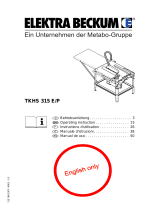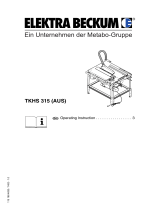
DANSK
18
1. Saven i overblik......................17
2. Læs først!................................ 18
3. Sikkerhedsoplysninger.......... 18
3.1 Tilsigtet brug............................. 18
3.2 Generelle
sikkerhedsoplysninger.............. 18
3.3 Symboler på maskinen.............20
3.4 Sikkerhedsudstyr...................... 20
4. Særlige produktegenskaber.. 21
5. Betjeningselementer.............. 21
6. Opstilling................................. 21
6.1 Opstilling................................... 22
6.2 Justere savklingen i forhold til
bordet ....................................... 22
6.3 Justere tværanslag...................22
6.4 Bordforlængelse.......................23
6.5 Strømtilslutning......................... 23
7. Betjening.................................24
7.1 Savning med parallelanslag ..... 24
7.2 Skæring med tværanslag ......... 25
7.3 Skære kile ................................26
8. Tips og tricks.......................... 26
9. Vedligeholdelse og pleje ....... 26
9.1 Udskiftning af savklinge............ 26
9.2 Afretning af spaltekniven .......... 27
9.3 Opbevaring af maskinen .......... 28
9.4 Vedligeholdelse........................ 28
10. Transport.................................28
11. Tilbehør som kan leveres . 28/74
12. Reparation............................... 28
13. Miljøbeskyttelse......................29
14. Problemer og forstyrrelser.... 29
15. Tekniske Data .........................30
Denne betjeningsvejledning er blevet
udført således, at du hurtigt og sikkert
kan arbejde med maskinen. I det efter
-
følgende beskrives, hvorledes du bør
læse denne betjeningsvejledning:
– Læs denne betjeningsvejledning
helt igennem før maskinen tages i
brug. Vær særlig opmærksom på
sikkerhedsoplysningerne.
– Denne betjeningsvejledning hen-
vender sig til personer med tekniske
kendskaber til omgangen med ma
-
skiner af den type som er beskrevet
her. Hvis du slet ingen erfaringer
har med sådanne maskiner, bør du i
første omgang bede erfarne perso
-
ner om at hjælpe dig.
– Opbevar alle dokumenter, der følger
med maskinen for at du kan se efter
hvis der skulle opstå tvivl. Gem
også kvitteringen til garantien.
– Hvis du låner maskinen ud eller
sælger den, skal alle medleverede
dokumenter også afleveres.
– Fabrikanten påtager sig intet ansvar
for skader, som følger af at denne
betjeningsvejledning ikke er blevet
overholdt.
Informationerne i denne betjeningsvej-
ledning er markeret som følger:
AFare!
Advarer mod personskader eller miljø-
skader.
BFare for strømstød!
Advarer mod personskader pga. elektri-
citet.
cRisiko for indgreb!
Advarer mod personskader som følge
af at legemsdele eller klædningsstykker
trækkes ind i maskinen.
A NB!
Advarer mod tingskader.
3 OBS:
Supplerende oplysninger.
– Tallene i billederne (1, 2, 3, ...)
– markerer enkeltdele;
– er nummereret fortløbende;
– henviser til tilsvarende tal i pa-
renteser (1), (2), (3) ... i den tilhø-
rende tekst.
– Handlingsanvisninger, hvor række-
følgen skal overholdes, er gennem-
nummereret.
– Handlingsanvisninger med en vil-
kårlig rækkefølge er markeret med
et punkt.
– Opstillinger er markeret med en
streg.
3.1 Tilsigtet brug
Denne maskine er bestemt til skæring
på langs og på tværs samt formatskæ
-
ring af massivt træ, spånplader, fiber-
plader samt disse materialer, når de er
belagt med plast eller udstyret med
plastkanter eller finer.
Runde emner må ikke saves, da de el-
lers kan fordrejes af den roterende sav-
klinge.
Enhver anden anvendelse er i strid
med formålet og er ikke tilladt. Produ
-
centen påtager sig intet ansvar for ska-
der som opstår i forbindelse med en
ukorrekt anvendelse.
Ved ukorrekt anvendelse, ved ændrin-
ger på maskinen eller ved brug af dele,
som ikke er testet eller godkendt af pro-
ducenten, kan der opstå alvorlige ska-
der og farer.
3.2 Generelle sikkerhedsop-
lysninger
• Overhold de følgende sikkerheds-
oplysninger ved brugen af denne
maskine for at undgå fare for perso-
ner eller tingskader.
• Overhold denne betjeningsvejled-
ning, især de specielle sikkerheds-
oplysninger i de respektive kapitler.
• Overhold de lovpligtige direktiver el-
ler forskrifter vedrørende ulykkes-
forebyggelse for omgangen med
rundsave.
AGenerelle farer!
• Hold orden på arbejdsområdet –
uorden i arbejdsområdet kan med-
føre alvorlige ulykker.
• Vær opmærksom. Vær opmærksom
på, hvordan du arbejder. Arbejd al-
tid fornuftigt. Maskinen må ikke an-
vendes, hvis du er ukoncentreret.
• Tag hensyn til omgivelsesbetingel-
serne. Sørg altid for ordentlig belys-
ning.
• Undgå usikre arbejdsstillinger. Sørg
for sikkert fodfæste og hold lige
-
vægten til enhver tid.
• Anvend egnede emneunderlag til
lange emner.
• Maskinen må ikke anvendes i nær-
heden af brændbare væsker eller
gasser.
Indholdsfortegnelse
2. Læs først!
3. Sikkerhedsoplysninger






















